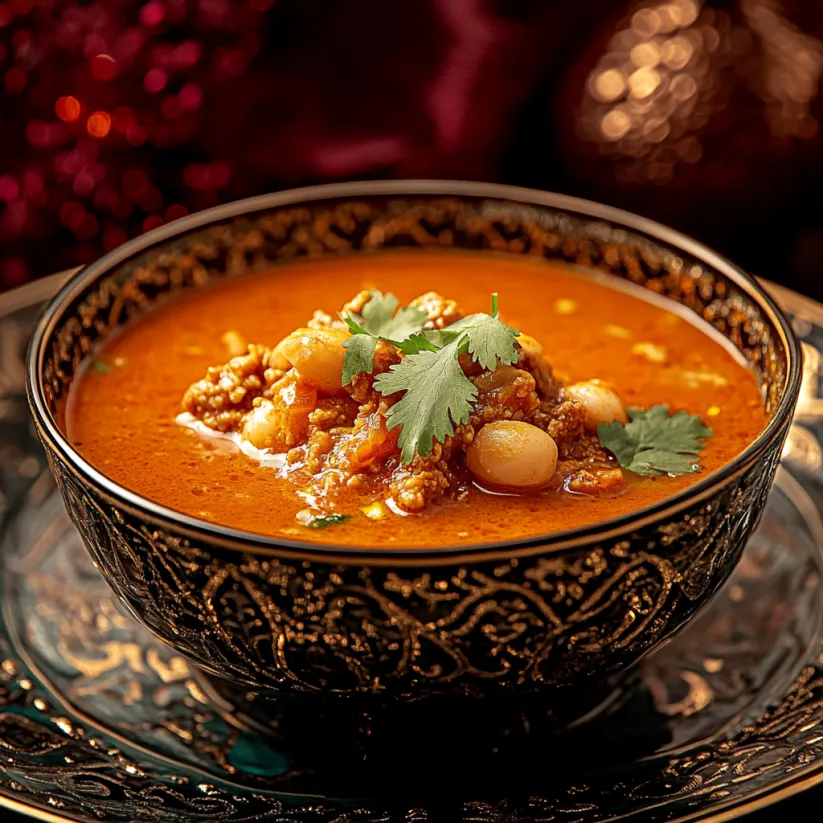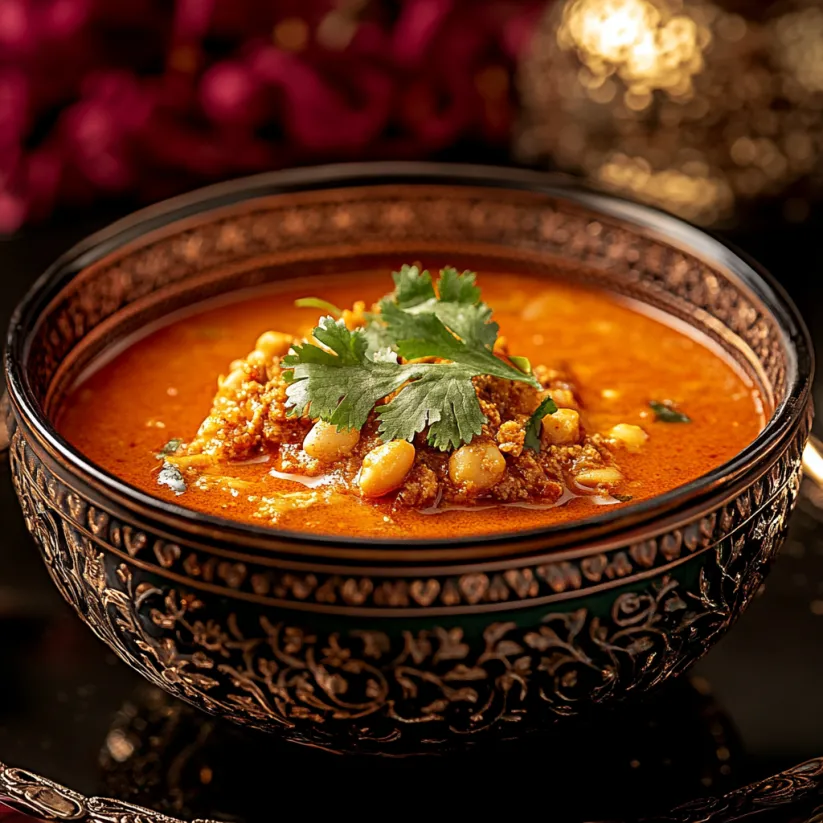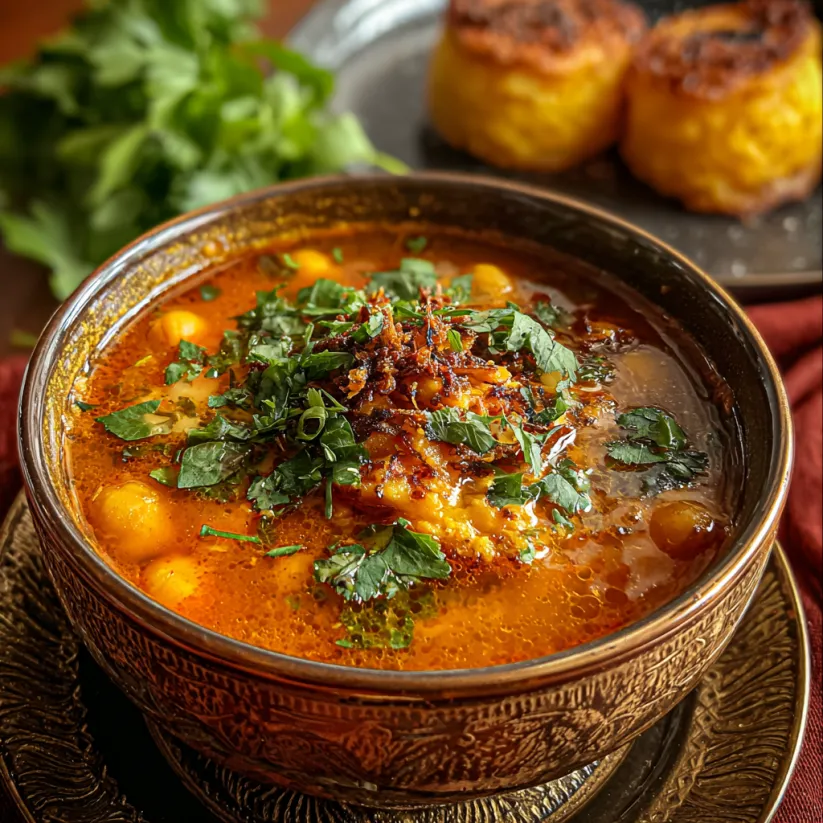 Bookmark
Bookmark
Harira – Moroccan National Soup is a traditional, aromatic, and hearty soup that holds a special place in Moroccan cuisine. It is often served during Iftar, the meal breaking the fast during Ramadan.
However, its deliciously rich and satisfying flavors make it a staple comfort dish enjoyed year-round. Combining tender meat, warming spices, and nutritious legumes, Harira is the perfect balance of warmth, nutrition, and depth of flavor.
This satisfying soup showcases Morocco’s culinary heritage, incorporating a symphony of spices such as cumin, paprika, cinnamon, and ginger, which create an unmistakable fragrance. With each spoonful, the interplay of tomatoes, lentils, chickpeas, and fresh herbs provides a wholesome and deeply nourishing experience. Whether enjoyed as a complete meal or a starter, Harira remains a timeless dish that brings people together.
Origins
Harira originates from Morocco and has deep cultural and historical significance. It is widely considered Morocco’s national soup, cherished for its nutritional value and rich taste. Historically, it has been a staple for centuries, evolving through influences from Berber, Arab, and Andalusian cuisines. Traditionally, Harira is served at Iftar, marking the end of the daily fast during Ramadan, as it provides a much-needed energy boost and replenishment.
Over time, the recipe has seen regional and household variations, but its core ingredients and essence remain the same. From Marrakech to Fez, and even beyond Morocco’s borders, Harira is celebrated as a comforting, wholesome dish that brings people together. Whether enjoyed in a bustling souk or at a family gathering, Harira remains a defining feature of Moroccan gastronomy.
Altogether, these elements make Harira a well-balanced and deeply flavorful soup, perfect for warming the soul on a cold day or serving as a revitalizing meal during Ramadan.
Serving suggestions for Harira
Accompanied by Fresh Moroccan Bread – Harira pairs wonderfully with Khobz (traditional Moroccan bread) or crusty baguettes, perfect for soaking up the flavorful broth.
With Dates and Honey – A common way to serve Harira during Ramadan is with sweet dates and honey, balancing the savory depth of the soup with natural sweetness.
With Hard-Boiled Eggs – A classic Moroccan pairing, hard-boiled eggs seasoned with cumin and salt add extra protein and richness to the meal.
Side dishes matching Harira
Moroccan Mint Tea – This refreshing and slightly sweet tea helps cleanse the palate and complements the warming spices of the soup.
Olives and Pickles – A plate of briny olives and pickled vegetables provides contrast to the soup’s rich and comforting texture.
Stuffed Grape Leaves – Also known as Dolma, these add an extra touch of Mediterranean flavor to round out the meal.
Variants
Chicken Harira – This version replaces lamb with chicken, making it slightly lighter while still maintaining the soup’s hearty character.
Vegetarian Harira – Instead of meat, extra lentils and chickpeas are used to maintain texture and protein, while vegetable broth substitutes chicken broth.
Spicy Harira – Adding extra cayenne and harissa gives this soup a fiery kick, making it ideal for spice lovers.
What do you need to make Harira?
- Extra-Virgin Olive Oil: The foundation of the soup, adding richness and enhancing the flavors of the aromatics.
- Lamb Shoulder or Chicken Meat: Provides a hearty base and deepens the flavor of the broth as it slowly simmers.
- Yellow Onion: Adds natural sweetness and depth to the soup’s aromatic profile.
- Spices (Paprika, Cumin, Coriander, Ginger, Cinnamon, Black Pepper, Cayenne): The key to the soup’s warm, complex, and authentic Moroccan flavor.
- Garlic: Enhances the savory depth of the dish, pairing perfectly with the warm spices.
- Tomato Paste and Crushed Tomatoes: Provides acidity, richness, and color to the broth.
- Chicken Broth and Water: Forms the liquid base of the soup, adding flavor and allowing all ingredients to meld together.
- Celery with Leaves: Introduces an earthy, fresh flavor that complements the spices.
- Chickpeas and Yellow Lentils: Adds heartiness, texture, and a boost of plant-based protein.
- All-Purpose Flour and Water: Creates a slight thickening effect, giving the soup a comforting consistency.
- Fresh Parsley: Adds brightness and a final herbal note to round out the dish.
- Lemon Juice: Provides a tangy finish, balancing the richness of the soup.
Harira step by step
- Step 1:
- Heat the olive oil in a large pot over medium heat. Add the lamb (or chicken) and sear until browned. Stir in the onion, half the salt, and cook until softened.
- Step 2:
- Stir in paprika, coriander, cumin, ginger, black pepper, cinnamon, and garlic. Cook for 1 minute, then mix in the tomato paste.
- Step 3:
- Pour in chicken broth, crushed tomatoes, celery, and water. Bring to a boil, then reduce heat and simmer for 45 minutes.
- Step 4:
- Stir in lentils and chickpeas. Continue simmering for 30 minutes until tender.
- Step 5:
- Mix flour and cold water, then stir it into the soup. Simmer until slightly thickened.
- Step 6:
- Stir in parsley, cayenne, and lemon juice. Adjust seasoning and serve warm.
 Bookmark
Bookmark
 Bookmark
Bookmark
Frequently Asked Questions
- → What meat is traditionally used in Harira?
Lamb shoulder is most traditional, though chicken can be used for a lighter variation.
- → Can Harira be made vegetarian?
Yes, simply omit the meat and use vegetable broth, adding extra legumes for texture and protein.
- → What gives Harira its rich flavor?
A combination of slow-cooked meat, legumes, tomatoes, and Moroccan spices like cumin, cinnamon, and paprika create deep flavor.
- → Is Harira eaten only during Ramadan?
No, while popular during Ramadan, Harira is enjoyed year-round as a comforting and satisfying dish.
- → What is the best way to serve Harira?
Traditionally with Moroccan bread, dates, and sometimes hard-boiled eggs seasoned with salt and cumin.
- → How is the soup thickened?
A slurry of flour and water is stirred in toward the end of cooking to slightly thicken the broth.
